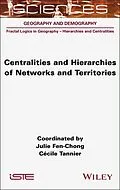Digital data, graph theory and spatial modeling allow us to apply the concepts of centralities and hierarchies to a wide variety of spatial situations.
The authors of this book offer insight into centralities and hierarchies within networks and territories at different scales and temporalities and for different socio-spatial phenomena. The first part of the book explores the contribution of data from cell phones and social networks to understanding the centralities and hierarchies of urban space within a circumscribed temporality. The second part uses network analysis - ecological networks, media networks and scientific knowledge networks - to propose indicators of spatial organization that reveal the centralities and hierarchies of spatial systems. Finally, in the third part, the territorial processes behind the formation of centralities and hierarchies are presented from a long-term perspective.
Autorentext
Julie Fen-Chong is Geographer and Research Professor at the Université Bourgogne Europe and the ThéMA laboratory, France. Her research interests concern mobility and its effects on the organization of space, which she studies using geomatic and interdisciplinary approaches.
Cécile Tannier is Director of Research in Geography at the ThéMA laboratory (CNRS, Université Marie et Louis Pasteur), France. Her research focuses on changes in the location of activities, the shape of cities and the dynamic modeling of settlement systems.
